Breathtaking Views From Top 10 Must-Visit Places in Nepal
Nestled in the heart of the Himalayas, Nepal beckons travelers with its majestic mountains, rich cultural tapestry, and spiritual sanctuaries. As one of the world's most captivating destinations, Nepal offers a blend of ancient traditions and breathtaking landscapes that leave an indelible mark on those who venture here. From the snow-capped peaks of the Himalayas to the bustling streets of Kathmandu, every corner of this diverse nation tells a story of resilience, spirituality, and natural beauty.
Nepal
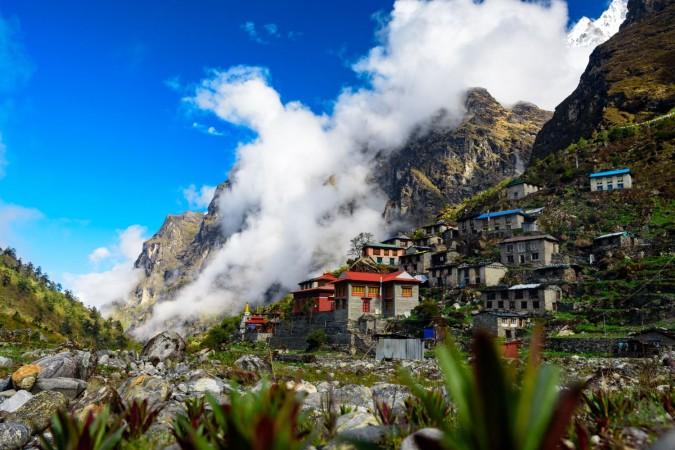
Overview of Nepal's Landscape
Nepal's allure as a tourism hotspot transcends mere geography; it is a testament to its cultural richness and natural splendor. Home to eight of the world's ten tallest mountains, including Mount Everest, Nepal is a haven for trekkers and mountaineers seeking to conquer its formidable peaks. Beyond the Himalayas, the Kathmandu Valley stands as a cultural crucible, where ancient temples, pagodas, and palaces narrate centuries of history and spiritual devotion.
Visitors to Nepal are greeted not only by its awe-inspiring landscapes but also by its warm and hospitable people, whose traditions and customs are woven intricately into the fabric of daily life. Whether exploring the bustling markets of Thamel in Kathmandu or embarking on a safari in the verdant jungles of Chitwan National Park, travelers encounter a spectrum of experiences that reflect Nepal's diversity and charm.
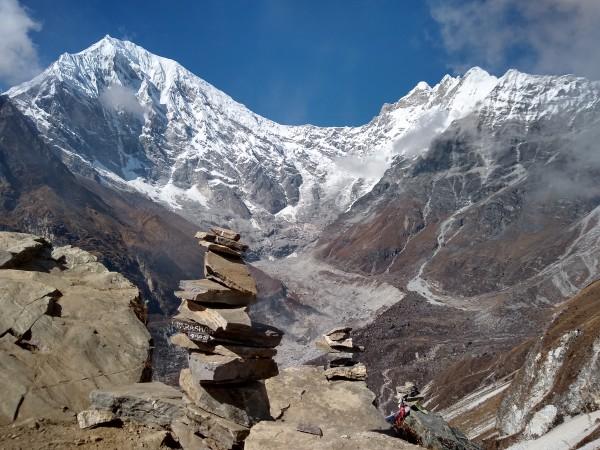
Langtang Valley - © Wikimedia
10 Must-Visit Places in Nepal - Paradise for Adventurers and Photographers
Kathmandu Valley - An Exhibit of Cultural Diversity
Nestled in the heart of Nepal, the Kathmandu Valley is a cultural treasure trove that encapsulates the country's rich history and spiritual legacy. Surrounded by soaring hills, this valley is home to three major cities—Kathmandu, Bhaktapur, and Patan—each boasting its own distinct charm and architectural wonders. Kathmandu Valley, a UNESCO World Heritage Site, stands as a testament to Nepal's royal history, featuring intricately carved palaces, temples, and courtyards that date back to the 12th century. Here, ancient craftsmanship meets spiritual devotion at the Swayambhunath Stupa, also known as the Monkey Temple, offers a panoramic view of the valley and a glimpse into Buddhism's profound influence on Nepalese culture.
- Best Time to Visit: During the spring (March to May) and autumn (September to November) seasons when the weather is mild, and skies are clear, offering ideal conditions for sightseeing and outdoor exploration.
- Travel Tips: Respect local customs when visiting religious sites. Engaging a local guide can enhance your experience by providing deeper insights into the cultural and historical significance of each landmark.
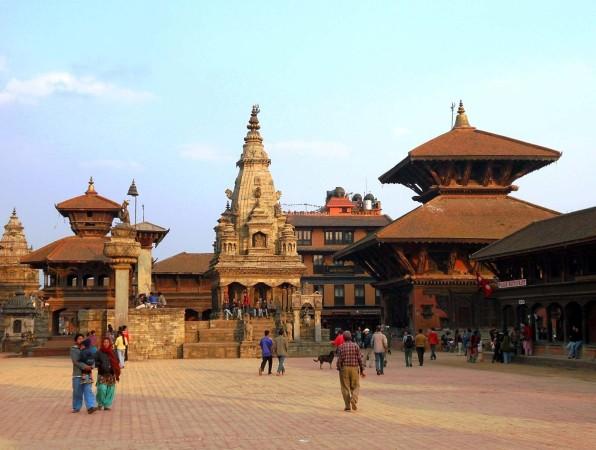
Kathmandu Valley - © Flickr
Pokhara - Tranquility at the lakeside
Pokhara, celebrated as Nepal's adventure capital, invites travelers with its tranquil lakes, mountain panoramas, and thrilling activities. Located at the base of the Annapurna range, this city blends relaxation and adventure amidst natural beauty. Phewa Lake, the second-largest lake in Nepal, according to the World Lake database, serves as Pokhara's centerpiece, where visitors can partake in boating excursions against the backdrop of the Annapurna and Machhapuchhre (Fishtail) mountains. Sarangkot, a hilltop village famed for its sunrise views, provides a stunning panorama of the Himalayan peaks bathed in golden light.
- Best Time to Visit: Autumn (September to November) is the ideal time to visit Pokhara when skies are clear, and visibility of the mountains is at its peak. Spring (March to May) also offers pleasant weather, making it suitable for outdoor activities.
- Travel Tips: Pokhara offers adventure sports like paragliding, hiking, and zip-lining. For a more relaxed experience, explore the city's vibrant lakeside cafes and markets, where local handicrafts and culinary delights await.
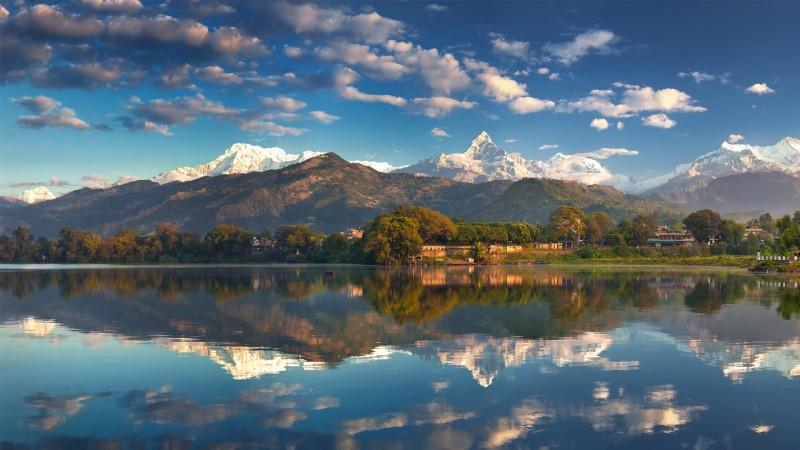
Pokhara - © MIA.vn
Chitwan National Park - Gift from Nature
Explore the heart of Nepal's animal refuge in Chitwan National Park, a UNESCO World Heritage Site known for its biodiversity and conservation efforts. Located in the subtropical lowlands of southern Nepal, this park offers a sanctuary for endangered species and a glimpse into Nepal's natural heritage. Chitwan's dense forests and grassy plains are home to diverse wildlife, including the iconic Bengal tiger, one-horned rhinoceros, and over 500 species of birds. Visitors are also provided an opportunity for cultural encounters with the indigenous Tharu community, known for their harmonious coexistence with the park's wildlife.
- Best Time to Visit: During the dry season from October to March, when wildlife sightings are more frequent, and weather conditions are favorable for outdoor activities.
- Travel Tips: Respect wildlife and follow park regulations during safaris. Opt for eco-friendly accommodations that support sustainable tourism practices and contribute to conservation efforts in the region.
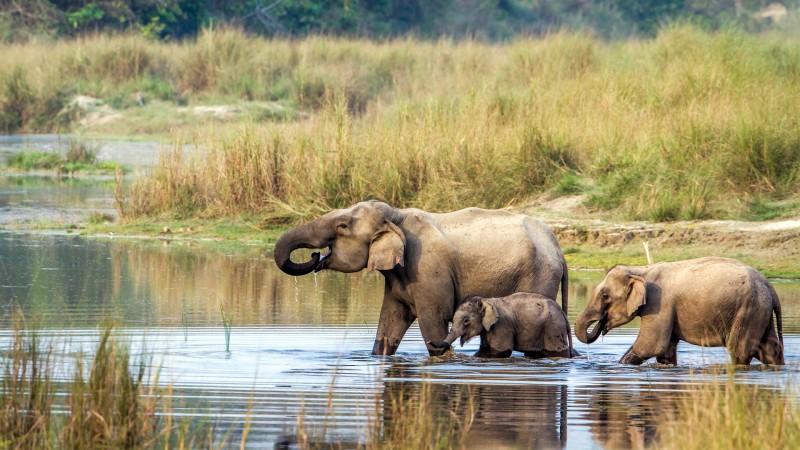
Chitwan National Park - © gather
Lumbini - The Buddha’s Birthplace
Lumbini, revered as the birthplace of Lord Buddha, holds profound spiritual significance and attracts pilgrims and travelers seeking enlightenment and cultural immersion. This UNESCO World Heritage Site, located in southern Nepal's Rupandehi District, is a pilgrimage site for Buddhists all over the world. Exploring Lumbini's Ashoka Pillar and Sacred Garden, designed to symbolize peace and harmony, offers visitors an opportunity to reflect on Buddha's teachings amidst landscaped gardens and monastic zones. The Lumbini Museum offers a thorough view of Buddhism's history and progress via artifacts and displays dating back millennia.
- Best Time to Visit: During the winter months (December to February) for mild weather. The pilgrimage season around Buddha Jayanti (Buddha's birthday) in May also offers a vibrant cultural experience.
- Travel Tips: Dress modestly and maintain a respectful demeanor when visiting sacred sites. Engage with local monastics and scholars to deepen your understanding of Buddhist philosophy and Lumbini's significance in global Buddhism.
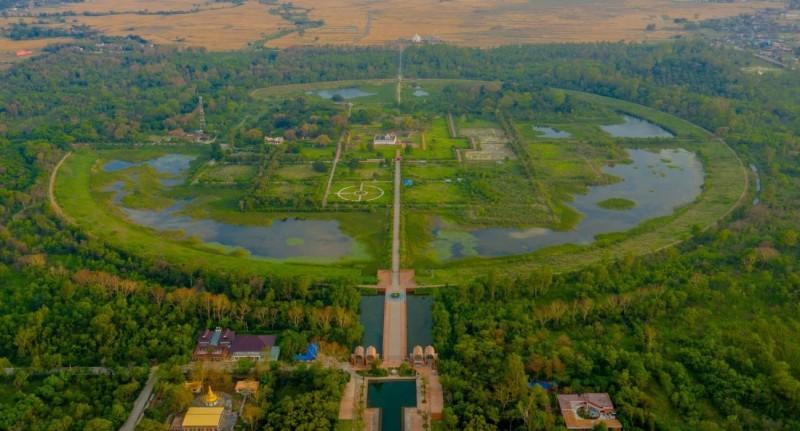
Lumbini - © Photohipster
Everest Base Camp - Doorstep to Himalayan Odyssey
Embark on an epic journey to Everest Base Camp, a pilgrimage for mountaineers and adventure seekers drawn to the world's highest peak, Mount Everest. Located in the Khumbu region of northeastern Nepal, this iconic trek offers unparalleled vistas and a profound sense of accomplishment amidst the Himalayan giants. Reaching Everest Base Camp itself, nestled at an altitude of 5,364 meters (17,598 feet), offers a humbling perspective on the world's highest peak and the challenges faced by climbers attempting its summit. The Khumbu Icefall and views of the imposing Everest south face underscore the expedition's gravity and allure for mountaineers from across the globe.
- Best Time to Visit: During the pre-monsoon (spring) season from March to May and the post-monsoon (autumn) season from September to November, when weather conditions are stable, and skies are clear for optimal mountain views.
- Travel Tips: Prepare adequately for high-altitude trekking with proper gear, including sturdy trekking boots, layered clothing, and a comprehensive first aid kit. To guarantee a safe and enjoyable trekking journey, follow the route instructions.
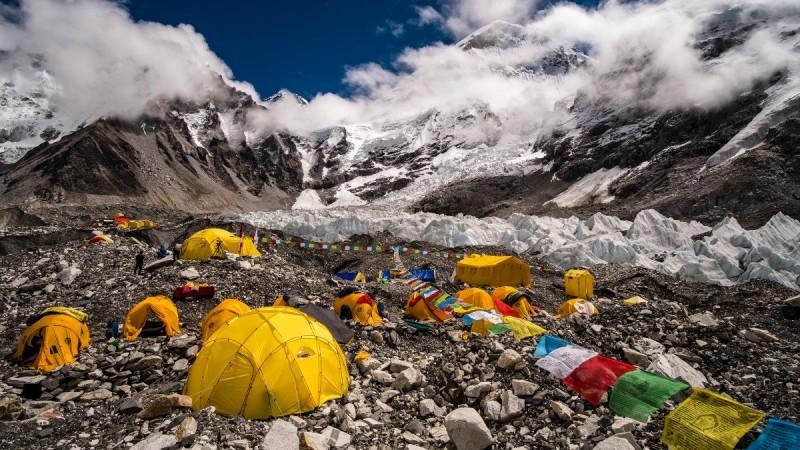
Everest Base Camp - © BBC
Bhaktapur - Timeless Charm of Architecture
Travel back in time to the ancient city of Bhaktapur, which is known for its well-preserved architecture and strong cultural history. Located in the Kathmandu Valley, Bhaktapur, also known as Bhadgaon transports visitors to a bygone era of Newar craftsmanship and tradition. Bhaktapur Durbar Square, the city's centerpiece, showcases a stunning collection of palaces, temples, and courtyards adorned with intricate wood carvings and ancient artwork. The Nyatapola Temple, dedicated to the goddess Siddhi Lakshmi, stands as a testament to Nepal's architectural prowess with its five-tiered pagoda structure towering over the square.
- Best Time to Visit: Bhaktapur is best visited during the spring (March to May) and autumn (September to November) seasons when the weather is pleasant, and cultural festivities are in full swing.
- Travel Tips: Engage with local artisans to learn about traditional pottery-making techniques and support the preservation of Bhaktapur's cultural heritage through responsible tourism practices.
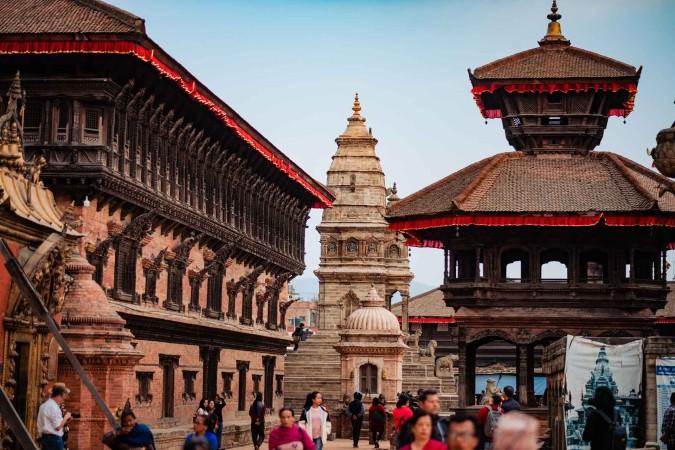
Bhaktapur Durbar Square - © Wikimedia
Patan (Lalitpur) - Architecture Jewel in Kathmandu Valley
Patan, also known as Lalitpur, is another jewel in the Kathmandu Valley's crown, celebrated for its ancient architecture, artistic traditions, and spiritual sanctuaries. This city of fine arts is distinguished by its well-preserved palaces, temples, and monastic complexes that reflect Newar craftsmanship and Hindu-Buddhist syncretism. Patan Durbar Square captivates visitors with its palatial courtyards, intricate wood carvings, and ancient statues dedicated to Hindu deities. Art enthusiasts flock to Patan's Patan Museum, housed in a restored palace, which showcases a remarkable collection of ancient artifacts, sculptures, and religious art spanning centuries of Nepalese history.
- Best Time to Visit: Patan is best visited during the autumn (September to November) and spring (March to May) seasons when mild weather and clear skies enhance the exploration of its architectural wonders and cultural landmarks.
- Travel Tips: Participate in traditional Newar festivals and cultural events to immerse yourself in Patan's vibrant artistic traditions and community spirit. Support local artisans by purchasing handmade crafts and souvenirs crafted in Patan's renowned workshops.
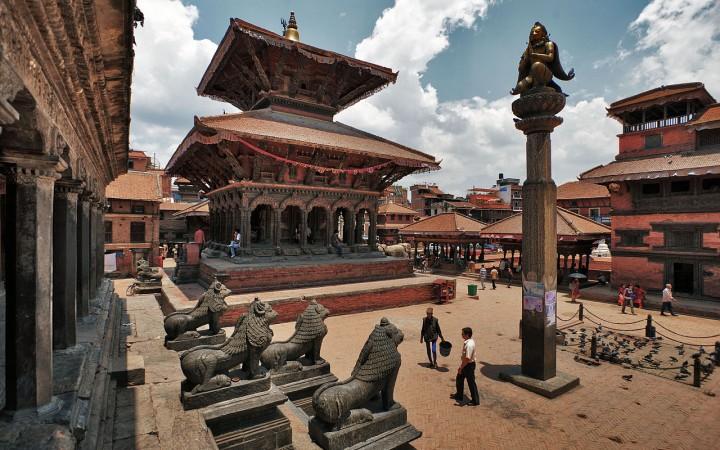
Patan (Lalitpur) - © Wikimedia
Bandipur - Relic of the Old World
Tucked away in the hills of central Nepal, Bandipur exudes old-world charm and tranquility, offering a glimpse into the country's rural life and panoramic mountain vistas. This quaint hilltop town, once a vital stop on the trade route between Tibet and India, boasts preserved Newari architecture and a relaxed atmosphere. Bandipur's Main Street, lined with historic buildings adorned with traditional windows and carved wooden facades, evokes a sense of stepping back in time to Nepal's mercantile past. The town's strategic location offers breathtaking views of the Annapurna, Dhaulagiri, and Manaslu mountain ranges, making it a favorite among nature enthusiasts and photographers.
- Best Time to Visit: Bandipur's temperate climate makes it an appealing destination year-round for outdoor activities and mountain views.
- Travel Tips: Stay in heritage guesthouses or boutique hotels that showcase traditional Newari architecture and hospitality. Engage with local communities through cultural homestays and guided village tours to gain insight into rural life in Nepal.
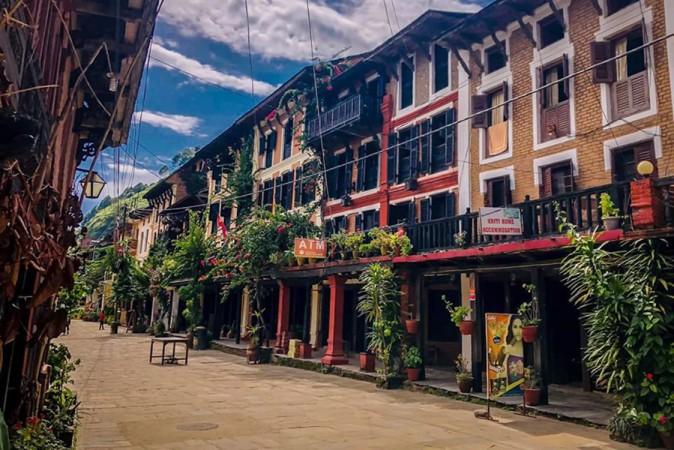
Bandipur - © gather
Annapurna Circuit - Trekking Heaven for Adventurous Souls
For avid trekkers seeking an immersive Himalayan adventure, the Annapurna Circuit offers a legendary trekking experience through diverse landscapes, remote villages, and awe-inspiring mountain vistas. The trek begins in the vibrant city of Pokhara, where trekkers embark on a journey through terraced hillsides, lush forests, and high mountain passes, including the formidable Thorong La Pass. Along the route, villages such as Manang and Muktinath offer glimpses into Tibetan Buddhist culture and traditions amidst breathtaking Himalayan scenery.
- Best Time to Visit: The ideal times to hike the Annapurna Circuit are in the fall (September to November) and spring (March to May), when the weather is pleasant and the mountain vistas are clear.
- Travel Tips: Acclimatize properly to high altitudes and follow a gradual ascent schedule to minimize the risk of altitude sickness. Engage with local guides and porters to support sustainable tourism practices and learn about the region's ecology and cultural significance.
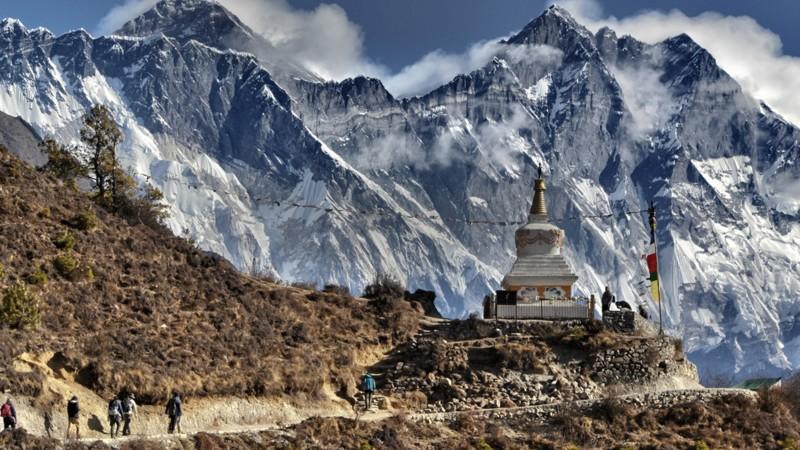
Annapurna Circuit - © gather
Khumbu Valley - Challenge for the Brave Souls
Explore the fabled Khumbu region, home to the world's highest peak, Mount Everest, and immerse yourself in Sherpa culture, breathtaking landscapes, and Himalayan hospitality. Located in northeastern Nepal, the Khumbu region offers trekkers and adventurers an unparalleled opportunity to experience the majesty of the Himalayas up close. En route to Everest Base Camp, trekkers pass through Tengboche Monastery, a spiritual center of Tibetan Buddhism nestled amidst rhododendron forests and snowy peaks. The monastery hosts traditional ceremonies and offers insights into Sherpa culture and religious practices.
- Best Time to Visit: The prime trekking seasons for the Khumbu region are autumn (September to November) and spring (March to May) when the weather condition is stable and the sky is clear.
- Travel Tips: Respect local customs and traditions, including Buddhist practices and environmental conservation efforts. Support local Sherpa communities by staying in tea houses and lodges operated by Sherpa families, contributing to sustainable tourism in the region.
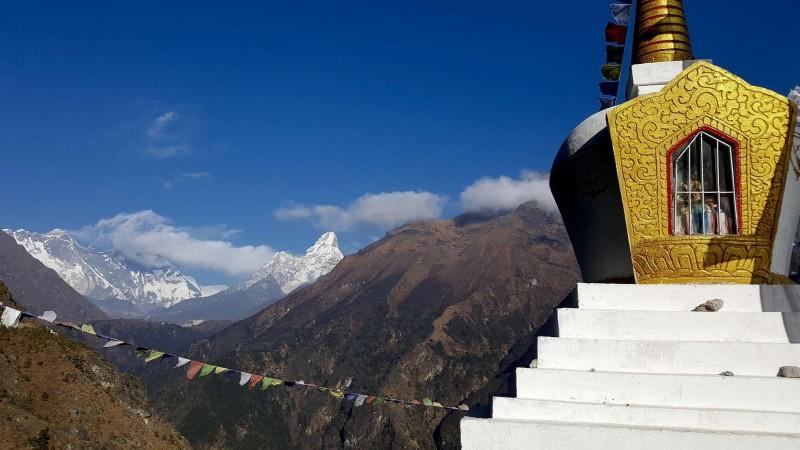
Khumbu Valley - © SummitPost
Conclusion
Nepal, with its majestic Himalayan peaks, ancient cities, and vibrant cultural tapestry, stands as a testament to the enduring allure of travel. From the spiritual serenity of Lumbini to the adrenaline rush of Everest Base Camp, each destination offers a unique blend of natural beauty, cultural richness, and immersive experiences that captivate the soul. As you plan your journey to Nepal, consider the diverse array of must-visit places and experiences that await. Whether you seek spiritual enlightenment, outdoor adventure, or cultural discovery, Nepal promises to exceed your expectations and leave you with memories to cherish for a lifetime.
Articles for you

Experience Aboard The RV Indochine II - A Mekong Cruise With Tweet World Travel
The RV Indochine II is a luxury river cruise ship, offering an unforgettable journey through many attractions along the Mekong River. Built in 2017, this upscale vessel combines colonial elegance with modern conveniences to create a comfortable yet stylish environment for its crew and passengers. The ship’s intimate size makes it ideal for those seeking a more personal cruising experience while exploring Vietnam and Cambodia rich culture, scenery, and heritage. Whether you're gazing at the landscape from your private balcony or enjoying authentic local cuisine, RV Indochine II promises an exotic adventure like no other.

Witness Stilt Fishing In Sri Lanka: An Eco-Tourism Experience
Sri Lanka, renowned for its stunning beaches and rich cultural heritage, harbors a unique tradition that has captivated travelers for centuries: stilt fishing. This ancient practice, passed down through generations of coastal communities, blends artistry with necessity, offering a glimpse into a way of life intimately connected to the island's coastal rhythms. Stilt fishing in Sri Lanka isn't merely a means to catch fish; it's a cultural emblem, embodying the resilience and ingenuity of Sri Lanka's fishing communities.

Make Your Trip Stress-Free With The Tweet Trip App
Embark on your next adventure with confidence by downloading the Tweet Trip App, available for both iOS and Android. This essential travel companion allows you to view your detailed itinerary, stay connected with your tour guide and fellow travelers, receive real-time updates, and provide feedback effortlessly. With features like in-app messaging, emergency assistance, and location sharing, the Tweet Trip App ensures you travel smarter, stay connected, and enjoy a seamless, worry-free journey. Get started today and make the most of your travel experience with Tweet World Travel.

Pedal Through Paradise: Unveiling Cambodia's Hidden Gems on Two Wheels
The gentle whir of bicycle wheels mingles with the distant chants of monks as you glide past emerald rice paddies stretching to the horizon. This is Cambodia - a sensory explosion waiting to be experienced on two wheels. At Tweet Tours, we believe there's no better way to immerse yourself in the Kingdom of Wonder than by bicycle.
Cambodia isn't just a destination; it's a living, breathing tapestry of ancient wonders, natural beauty, and vibrant culture. Our carefully crafted cycling tours take you beyond the typical tourist haunts, offering a unique perspective on this captivating country. Ready to clip in and discover the magic of Cambodia? Let's ride!

Trekking in the Himalayas: A Journey Through Nepal's Majestic Peaks
The Himalayas rise from the earth like colossal guardians, their snow-capped peaks piercing the sky in a display of nature's raw power and beauty. Nepal, nestled at the heart of this mountain range, serves as the gateway to some of the most breathtaking trekking experiences on the planet. Here, the air is crisp and thin, filled with the promise of adventure and the whispers of ancient tales.
With Tweet Tours, as you set foot on these hallowed trails, you're not just a traveler - you're a modern-day explorer, following in the footsteps of legendary mountaineers and age-old traders. Each step takes you further into a world where nature reigns supreme and human resilience is tested against the backdrop of some of the world's highest peaks.
From the moment your boots touch the ground in Kathmandu, you'll feel the pull of the mountains. The bustling streets of the capital, with their sensory overload of sights, sounds, and smells, soon give way to serene mountain paths where the only soundtrack is the crunch of gravel underfoot and the distant tinkling of yak bells.

Exploring Mui Ne's Wonders: Unique Attractions & Local Dishes
Nestled along the southeastern coast of Vietnam, Mui Ne emerges as a captivating gem, blending natural wonders with cultural richness. Renowned for its stunning landscapes and unique attractions, Mui Ne beckons travelers seeking both relaxation and adventure in equal measure. Mui Ne's renowned beach dunes, bustling fishing towns, and excellent local food await exploration at every turn.
The allure of Mui Ne lies not only in its pristine beaches and crystal-clear waters but also in its diverse range of activities catering to every traveler's whims. Whether you're drawn to thrilling water sports like kitesurfing and windsurfing on its dynamic shores or seeking tranquility amidst the picturesque Fairy Stream, Mui Ne promises an unforgettable journey filled with discovery.
